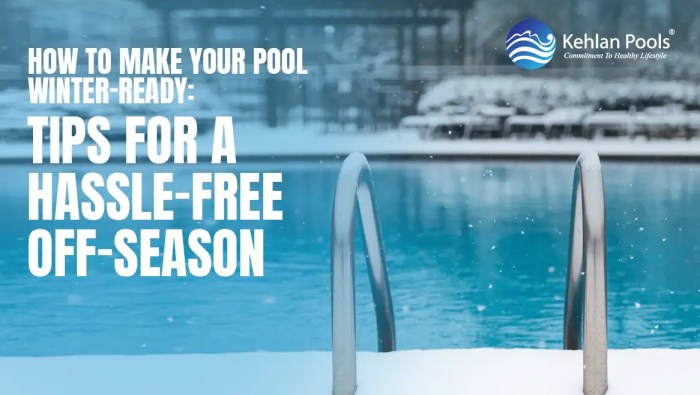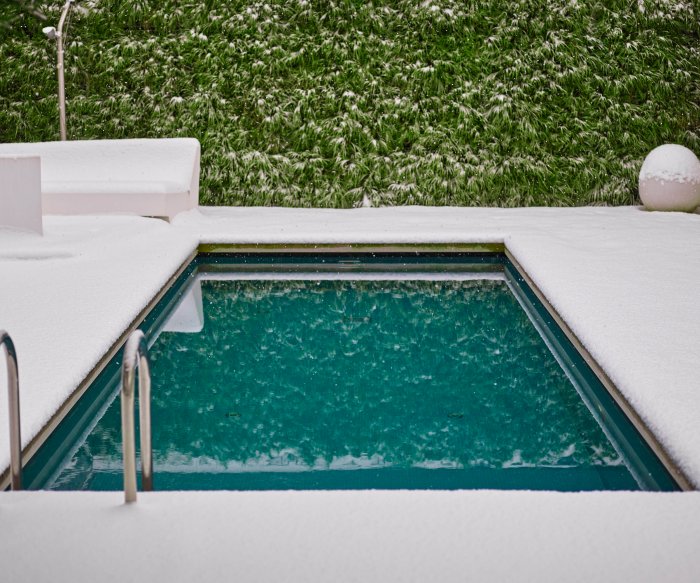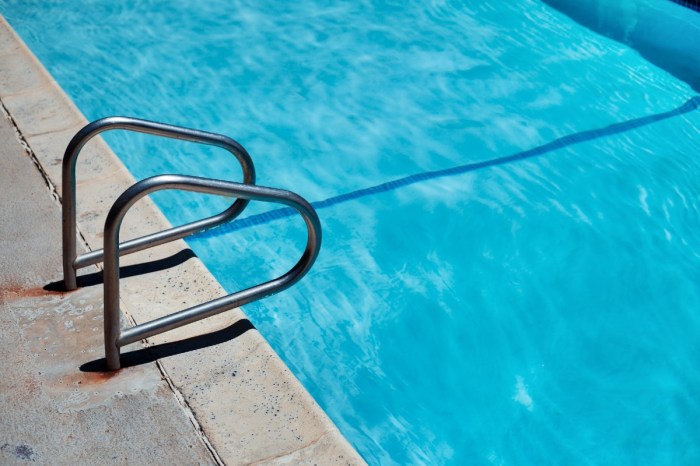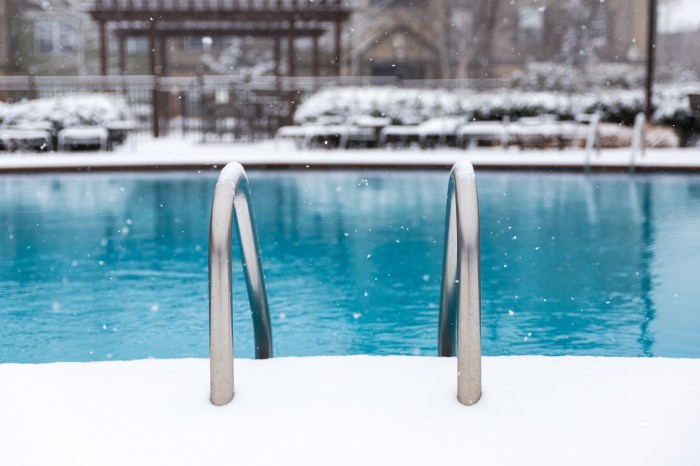Winterizing Your Pool Equipment

Source: shortpixel.ai
How to maintain a backyard pool in the winter – Proper winterization of your pool equipment is crucial to prevent damage from freezing temperatures and ensure a smooth start to the swimming season next year. Neglecting this step can lead to costly repairs or even complete equipment replacement. This section will guide you through the process of winterizing your pool pump, filter, heater, and chlorinator.
Winterizing Your Pool Pump
Before winter arrives, it’s essential to prepare your pool pump for the cold months. The main goal is to remove all water from the pump to prevent freezing and cracking. This can be achieved through draining the pump completely or using antifreeze. Draining involves removing all water from the pump housing and plumbing, while using antifreeze involves filling the pump with a non-toxic solution designed to protect against freezing.
Both methods have advantages and disadvantages, as detailed in the table below.
Storing Pool Filters
Proper filter storage is just as important as pump winterization. Leaving your filter submerged in pool water over winter invites algae growth and potential damage. After thoroughly rinsing your filter to remove debris, allow it to completely dry in a clean, dry, and well-ventilated area. This prevents mold and mildew growth, extending the filter’s lifespan. Avoid storing the filter in direct sunlight or extreme temperatures.
Winterizing Pool Equipment Checklist
A comprehensive checklist helps ensure you haven’t overlooked any critical steps. This checklist provides a systematic approach to winterizing your entire pool equipment system.
- Pool Pump: Drain completely or fill with antifreeze. Disconnect from power.
- Pool Filter: Thoroughly clean and completely dry before storing in a suitable location.
- Pool Heater: Drain completely, disconnect from power, and cover to protect from the elements. Consult your heater’s manual for specific instructions.
- Pool Chlorinator: Remove any chlorine tablets or granules. If applicable, drain and store the chlorinator indoors in a dry place. Consult your chlorinator’s manual for specific instructions.
- Pool Plumbing: Ensure all above-ground plumbing lines are drained to prevent freezing.
- Automatic Pool Cleaners: Remove and store indoors, following manufacturer’s instructions.
Preventing Freezing Damage to Pool Equipment
Freezing water expands, exerting immense pressure that can crack and damage pool equipment. The most effective way to prevent this is to completely remove all water from the equipment or replace it with a non-toxic antifreeze solution. Always follow the manufacturer’s instructions for your specific equipment. Protecting exposed equipment with covers or insulation can provide an extra layer of protection against the elements.
Comparison of Pool Pump Winterization Methods
| Method | Advantages | Disadvantages | Suitability |
|---|---|---|---|
| Complete Draining | Cost-effective; No chemicals involved. | Requires more effort; Risk of residual water causing damage if not fully drained. | Best for pumps easily accessible and fully drained. |
| Using Antifreeze | Simpler; Less risk of residual water damage. | Requires purchasing antifreeze; Potential environmental concerns if improperly disposed of. | Suitable for pumps where complete draining is difficult. |
Pool Water Chemistry Maintenance

Source: futurecdn.net
Proper pool water chemistry is crucial year-round, but it’s especially important before winterizing your pool. Neglecting this step can lead to significant problems come spring, costing you time and money in repairs and cleaning. Maintaining the correct balance protects your pool’s surfaces and equipment from damage caused by harsh chemicals or imbalanced water.Maintaining balanced water chemistry throughout the winter prevents damage to your pool’s structure and equipment.
Consistent levels prevent corrosion of metal components, staining of pool surfaces, and the growth of algae and bacteria, even in a closed or winterized pool.
Effects of Imbalanced pH Levels
Low pH (acidic water) can corrode pool surfaces, especially plaster and metal components. High pH (alkaline water) can cause scaling and cloudiness, reducing the effectiveness of sanitizers and leading to a less pleasant swimming experience (should you choose to use it in the winter). Both extremes compromise the longevity and aesthetic appeal of your pool. For example, a consistently low pH can etch the finish of a fiberglass pool, while high pH can leave unsightly calcium deposits on the walls and floor.
Testing and Adjusting Pool Water Chemistry
Regular testing is key. Use a reliable test kit – either liquid or test strips – to check your pH, alkalinity, and sanitizer levels. Follow the kit’s instructions carefully. Adjusting the levels involves adding appropriate chemicals, such as pH increaser (sodium carbonate) to raise pH or pH decreaser (sodium bisulfate) to lower it. Similarly, you’ll use alkalinity increaser (sodium bicarbonate) or decreaser (dry acid) to adjust alkalinity.
Always add chemicals slowly and evenly, with the pump running, and stir gently to ensure proper distribution. Remember to always wear appropriate safety gear when handling pool chemicals.
Preventing Algae Growth in a Winterized Pool
Even a winterized pool isn’t immune to algae growth. Before closing, ensure your water is properly balanced, particularly the sanitizer level. A higher-than-normal sanitizer level (chlorine or bromine) acts as a deterrent against algae growth during the winter months. While algae growth is less likely in colder temperatures, a proper sanitizer level is still the best preventative measure.
Regularly check your water levels, and if necessary, add more sanitizer. Remember that winterizing covers are not completely airtight and some algae can still grow.
Ideal Winterized Pool Water Chemistry Levels
Maintaining the correct chemical balance is vital for protecting your pool investment during the off-season. Here’s a guideline for ideal levels:
- pH: 7.2 – 7.8
- Total Alkalinity: 80 – 120 ppm
- Calcium Hardness: 200 – 400 ppm
- Sanitizer (Chlorine): 3.0 – 5.0 ppm
Pool Cover Selection and Installation
Choosing the right pool cover and installing it correctly is crucial for protecting your pool throughout the winter. A properly installed cover prevents debris from entering the water, minimizes evaporation, and helps maintain water temperature, ultimately saving you time and money in the spring. The type of cover you select will depend on your budget, the level of protection you need, and your pool’s specific requirements.
Pool Cover Types: A Comparison
There are three main types of pool covers: safety covers, mesh covers, and solid covers. Each offers different benefits and drawbacks. Safety covers are designed to meet specific safety standards, preventing accidental falls into the pool. Mesh covers allow for some sunlight penetration, which can help prevent algae growth but offer less protection against debris. Solid covers provide the best protection against debris and evaporation but can be more expensive and require more effort to remove and clean.
Safety Cover Installation
Safety covers are typically anchored to the deck surrounding the pool using straps and winches. The installation process usually involves carefully laying the cover over the water’s surface, ensuring it’s evenly distributed. Then, using the straps and winches, you’ll gradually tighten the cover, securing it to the anchors. It’s essential to follow the manufacturer’s instructions precisely to ensure a secure and safe installation.
Improper installation can lead to the cover becoming dislodged, potentially causing damage or injury. The final step involves attaching the safety cover’s locking mechanisms to prevent unauthorized access.
Securing Pool Covers Against Wind Damage
Wind can be a significant threat to pool covers, especially in areas prone to strong gusts. To mitigate wind damage, ensure the cover is properly tensioned during installation, leaving minimal slack. Use additional weights or straps around the perimeter of the cover to further secure it, particularly in high-wind areas. Consider using sandbags or heavy objects at strategic points around the pool’s edge to add extra weight and stability to the cover.
Regularly inspect the cover for any signs of damage or looseness and make adjustments as needed.
Debris Removal from Pool Covers
Over time, leaves, twigs, and other debris will accumulate on your pool cover. Regular cleaning is essential to prevent the cover from becoming excessively weighted and potentially damaged. Start by using a soft-bristled brush or broom to sweep off loose debris. For stubborn debris, a leaf blower can be effective. For heavier debris, carefully lift a section of the cover and remove the debris from underneath.
Always be careful not to tear or damage the cover during the cleaning process. After cleaning, thoroughly inspect the cover for any signs of damage and repair as necessary.
Pool Cover Material Comparison
| Cover Type | Pros | Cons | Cost |
|---|---|---|---|
| Safety Cover | Excellent safety, prevents debris, strong | Expensive, can be difficult to install and remove, requires more storage space | High |
| Mesh Cover | Allows sunlight penetration, relatively inexpensive, lightweight | Less debris protection, may not prevent all evaporation | Medium |
| Solid Cover | Excellent debris protection, minimizes evaporation, good insulation | Expensive, heavy, can be difficult to handle | High |
Protecting Your Pool Structure: How To Maintain A Backyard Pool In The Winter

Source: ownthepool.com
Winterizing your pool isn’t just about the water; it’s about safeguarding the entire structure from the harsh elements. Freezing temperatures and ice expansion can cause significant damage to your pool’s shell, coping, and surrounding areas if not properly addressed. Taking preventative measures now will save you considerable time, money, and frustration in the spring.Protecting your pool structure from winter’s wrath involves understanding the potential dangers and implementing proactive strategies.
The most significant threat is, of course, freezing water. Water expands when it freezes, exerting immense pressure on anything containing it. This pressure can crack concrete, damage tile, and even compromise the structural integrity of your pool itself. Beyond freezing, ice can cause physical damage through abrasion if it’s allowed to build up and shift against the pool walls.
Preventing Damage from Freezing Temperatures
The key to preventing freeze damage is to ensure that no water within the pool structure itself is allowed to freeze. This means keeping the water level appropriately low (as discussed in the pool water chemistry section) and utilizing a winter cover to minimize water temperature fluctuations. Additionally, consider draining all water lines and equipment that might be susceptible to freezing, such as skimmers, returns, and any exposed plumbing.
In areas with extremely harsh winters, using a pool cover pump to remove excess water from the cover can be a significant additional preventative measure. In particularly frigid climates, you may also need to consider the use of specialized antifreeze solutions in plumbing lines.
Protecting the Pool Deck and Surrounding Areas
The pool deck and surrounding landscaping are also vulnerable to winter damage. Repeated freeze-thaw cycles can weaken concrete, causing cracking and deterioration. Snow and ice accumulation can lead to slipping hazards and damage to pavers or other deck materials. Preventative measures include clearing snow regularly, using de-icing products carefully (avoiding harsh chemicals that could damage the deck or pool finish), and applying sealant to concrete surfaces to protect them from moisture penetration.
Consider adding sand or grit to particularly icy areas for better traction.
Importance of Regular Winter Inspections
Regular inspections are crucial for catching potential problems early. Even with preventative measures in place, unforeseen issues can arise. Weekly checks for signs of cracking, settling, or ice buildup will allow you to address problems before they escalate. Pay close attention to the pool’s coping, the area where the pool shell meets the deck, and the condition of the winter cover itself.
Early detection can prevent costly repairs down the line.
Preventative Maintenance Tasks
Regular inspections are key to early problem detection. Here’s a list of preventative maintenance tasks to perform on your pool structure throughout the winter months:
- Inspect the pool shell and coping for cracks or damage after each significant snowfall or thaw.
- Check the pool cover regularly for tears, rips, or excessive ice accumulation. Remove ice carefully to avoid damage.
- Clear snow and ice from the pool deck and surrounding areas promptly to prevent buildup and damage.
- Monitor the ground around the pool for settling or heaving, which could indicate foundation problems.
- Inspect all exposed plumbing and equipment for signs of freezing or damage.
Dealing with Winter Pool Issues

Source: aquapools.com
Winterizing your pool is crucial, but even with the best preparation, problems can arise. Knowing how to identify and address these issues quickly can prevent significant damage and costly repairs. This section Artikels common winter pool problems and provides solutions for effective troubleshooting.
Identifying and Addressing Leaks and Cracks
Leaks and cracks are serious issues that can lead to structural damage and water loss. Regularly inspect your pool for signs of leakage, such as consistently low water levels, damp patches around the pool, or unusual water stains on the surrounding concrete. Small cracks can often be repaired with epoxy-based pool crack fillers, following the manufacturer’s instructions carefully.
Larger cracks or persistent leaks require professional attention from a qualified pool technician. They may need to excavate around the leak to access and repair the damage properly. For example, a hairline crack in the pool’s shell might only require a simple epoxy repair, while a larger crack caused by ground shifting might necessitate more extensive work, potentially including patching or even replacement of sections of the pool shell.
Damaged Pool Covers
Winter storms can inflict damage on pool covers. Regularly inspect your cover for tears, rips, or punctures. Small tears can be patched using a suitable repair kit designed for pool covers. For more extensive damage, replacing sections or the entire cover might be necessary. Consider using a winter cover specifically designed to withstand harsh weather conditions.
For instance, a heavy-duty, reinforced cover is more resistant to tearing from ice or wind compared to a lightweight, inexpensive cover. Promptly addressing damage prevents further deterioration and keeps debris from entering the pool.
Ice Buildup on the Pool Surface, How to maintain a backyard pool in the winter
Ice buildup can put significant pressure on the pool structure, potentially causing damage. While a properly installed and weighted pool cover helps prevent this, excessive ice can still form. Avoid walking on the ice, as this can further damage the cover. If ice buildup is significant, consider using a pool cover pump to remove the water before it freezes.
Never use sharp objects to break up the ice, as this risks damaging the pool or cover. The weight of the ice can be considerable, and breaking it up could lead to uneven pressure and structural stress on the pool walls and floor. For instance, several inches of ice can exert substantial force, potentially causing cracking or bowing of the pool structure.
Removing Accumulated Debris
After winter, debris such as leaves, twigs, and other organic matter will have accumulated on the pool surface and possibly at the bottom. Before refilling the pool, carefully remove all debris using a leaf net and pool skimmer. A pool vacuum can help remove debris from the bottom of the pool. For larger debris or significant amounts of sediment, you may need to drain a portion of the water to more effectively clean the pool floor.
Proper cleaning prevents the accumulation of organic matter that can contribute to algae growth and negatively impact water chemistry once the pool is reopened.
Troubleshooting Common Winter Pool Issues
The following flowchart Artikels troubleshooting steps for common winter pool problems:
| Problem | Possible Cause | Solution |
|---|---|---|
| Low Water Level | Leak, evaporation | Inspect for leaks, repair as needed, top off water if evaporation is the cause. |
| Damaged Cover | Wind, ice, debris | Repair or replace damaged sections; reinforce cover. |
| Excessive Ice Buildup | Insufficient cover weight, extreme cold | Use a pool cover pump to remove water before freezing; ensure proper cover installation. |
| Debris Accumulation | Wind, rain, snow | Remove debris using a leaf net, skimmer, and pool vacuum. |
| Cloudy Water (after winter) | Algae growth, debris | Clean the pool thoroughly, balance water chemistry, and potentially shock the pool. |
Visual Guide
A properly winterized pool presents a picture of calm and readiness for the cold months. It’s a scene of controlled dormancy, not neglect. The overall impression should be one of careful preparation, not abandonment.The water level is lower than usual, several inches below the skimmer opening. This prevents water pressure damage from freezing and expansion. Imagine the water line sitting noticeably below the usual fill level, leaving ample space between the water and the top of the pool’s walls.
The pool equipment, such as the pump and filter, is meticulously cleaned, drained, and protected from the elements. There are no visible signs of water damage or leakage around the equipment. All pipes and hoses are thoroughly drained and either stored indoors or protected with insulation.
Pool Water Level and Equipment
The water level is crucial. A properly winterized pool will have its water level lowered to several inches below the skimmer. This prevents water from expanding during freezing temperatures and causing damage to the pool walls or equipment. The pump and filter are completely drained and winterized; this means all the water has been removed and any necessary winterizing chemicals have been added.
The equipment is either covered with protective tarps or stored in a climate-controlled environment. All valves are shut off and secured. Any exposed plumbing or pipes are wrapped in insulation or protected by heat tape to prevent freezing.
Pool Cover Placement
The pool cover is taut and securely fastened, completely covering the pool’s surface. It’s not just loosely draped; it’s snug and properly weighted down to prevent shifting or damage from wind or snow. Think of it as a well-fitted blanket, smoothly spread across the entire surface, firmly anchored around the perimeter to prevent water from accumulating on top. Water should not be pooling on top of the cover.
The cover itself is designed for winter conditions, often made of heavy-duty, weather-resistant materials. Any necessary safety equipment, like a safety ladder, is either removed or properly secured and protected from the elements.
Overall Appearance
The overall appearance of a winterized pool should be neat, organized, and protected. The pool itself appears dormant, but not neglected. There are no visible signs of debris, algae, or damage. The area surrounding the pool is clean and free of hazards. The entire setup reflects a proactive and planned approach to winter pool maintenance.
The winterized pool is essentially prepared to safely endure the winter months, ready for spring’s reactivation.
Ending Remarks
Winterizing your pool might seem daunting, but by following these steps, you can ensure your pool remains in excellent condition until spring. Remember, a little preventative care now saves you significant time, money, and headaches later. So, take a deep breath, grab your checklist, and prepare for a winter where your pool is safe, sound, and ready for a fantastic swimming season next year! Happy winterizing!